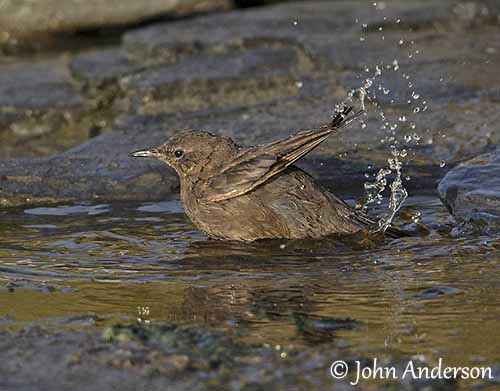
Fr: Cinclode fuligineux
All: Rußbrauner-Uferwipper
Esp: Remolinera Negra - Churrete austral
Ita: Batticoda antartico
Nd: Zwarte Wipstaart
Sd: Gråsvart cinclodes
Photographers:
John Anderson
John Anderson Photo Galleries
Tom Merigan
Tom Merigan’s Photo Galleries
Otto Plantema
Trips around the world
Text by Nicole Bouglouan
Sources:
HANDBOOK OF THE BIRDS OF THE WORLD Vol 8 By Josep del Hoyo-Andrew Elliott-David Christie - Lynx Edicions - ISBN: 8487334504
A GUIDE TO THE BIRDS OF COLOMBIA by Steven L. Hilty and William L. Brown - Princeton University Press – ISBN 069108372X
BirdLife International (BirdLife International)
Neotropical Birds – Cornell Lab of Ornithology
Wikipedia, la enciclopedia libre
Blackish Cinclodes
Cinclodes antarcticus
Passeriformes Order – Furnariidae Family
INTRODUCTION:
The Blackish Cinclodes (Tussock-bird in Falkland Islands) is very tame and can be seen hopping about at visitor’s feet. For this reason, it is vulnerable to introduced predators such as cats and rats, and the nominate race “antarcticus” from Falklands, is found in the areas where these predators are absent.
The genus “Cinclodes” is distributed in the cold regions of southern S America. These birds forage on the ground and are usually associated with water.
DESCRIPTION OF THE BIRD:
Biometrics:
Length: 19-20 cm
The adult of the nominate race has uniformly dark sooty brown plumage, except the slightly paler throat and some dull rufous on bases of flight feathers.
The bill is blackish. The eyes are dark brown. Legs and feet are blackish.
Both sexes are similar and the juvenile resembles adults.

SUBSPECIES AND RANGE:
C.a. antarcticus (here described and displayed) is found on Falkland Islands.
C.a. maculirostris is found in extreme S of South America, on Dawson Island, Brecknock Peninsula (SW Tierra del Fuego), Navarino Island, Cape Horn Archipelago and Staten Island.
This one is slightly larger and blacker than nominate. It has yellowish base of lower mandible, and lacks the rufous tinge on the wings.
HABITAT:
The Blackish Cinclodes is fairly abundant along coastal rocky or sandy beaches, and usually found in the vicinity of colonies of seabirds and marine mammals.
On Falkland Islands, it also frequents inland areas with tussock grass (Poa flabellata) and can be seen around habitations.

The breeding season involves courtship displays. The male performs typical “wing-raising”, and slow “wing-flagging” displays, accompanied by song. These displays are used both in courtship and territorial defence. The male is usually perched on elevated place, a rock or other suitable perch. They are monogamous.
The Blackish Cinclodes is resident in its restricted range.
It may perform relatively long flights between its foraging sites. It has long wings and large primary extensions.
PROTECTION / THREATS / STATUS:
The Blackish Cinclodes has restricted range where it is uncommon to locally common.
This species is confined to islands free of introduced predators such as cats and rats.
The Falklands’ population is estimated at about 10,000 breeding pairs. The other populations are suspected to be declining, due to predation by invasive species.
However, the Blackish Cinclodes is currently evaluated as Least Concern.

Blackish Cinclodes (background)
with Austral Thrush
CALLS AND SONGS: SOUNDS BY XENO-CANTO
The Blackish Cinclodes’ call is a “chip”. The song is a loud, long series of sharp staccato notes, interspersed with more musical trills. This song is sometimes given in flight.
On Falklands Islands, the nominate race utters a tittering “chee-chee-chee-chee-cheecheecheecheecheechee”, but we can also hear another type of phrase “chit-chit-chit-chit-chitter-chitter-ee-ee-ee”.
BEHAVIOUR IN THE WILD:
The Blackish Cinclodes feeds mainly on invertebrates such as arthropods, marine invertebrates, Diptera and their larvae, and Orthoptera.
This species is more omnivorous in Falklands were it forages among the floating rotting kelps or in tussac grass. It feeds on cracked eggs of Spheniscidae, and also takes regurgitated food and excreta from seals and seabirds.
It forages alone or in pairs, gleaning food on beaches. It probes in kelp debris to reach invertebrates. It may leap upwards to catch flies from the air.

REPRODUCTION OF THIS SPECIES:
The breeding season takes place during the austral spring/summer.
In Falkland Islands, eggs are recorded in October, and a second brood may occur in December.
The Blackish Cinclodes nests in tunnel in a bank facing the sea, or in hole or rock crevice in rocky coasts, in boulders or old building, a hole in a log, an old burrow abandoned by other bird species, or under dense vegetation.
The nest is at the end of the tunnel. The nest-chamber is lined with dried grass, root fibres and feathers. Other materials can be added through the nesting period.
The female lays 2-3 eggs and the incubation lasts two weeks. The chicks are fed by both parents and fledge about 25 days after hatching.
This species can produce two broods per season.
